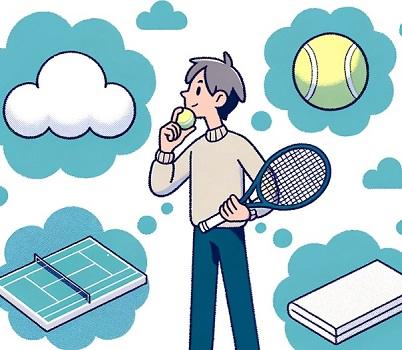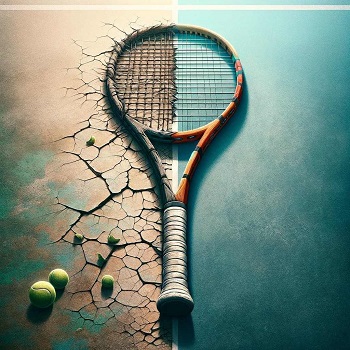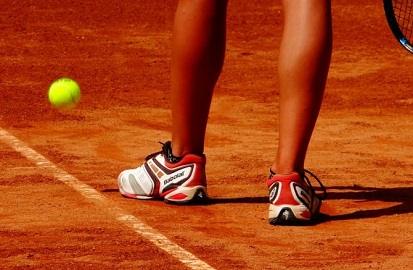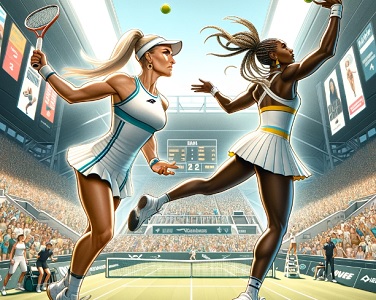Why Do Tennis Balls Have Felt?

An Insight into the Game’s Essential Equipment
Tennis is a game of precision, speed, and technique. Every component of the game, from the racquet to the shoes, plays a crucial role in determining the outcome of a match. Among these components, the tennis ball, adorned with its distinctive fuzzy felt, is perhaps the most iconic. But have you ever wondered why tennis balls have felt? Let’s delve into the reasons behind this unique design choice.
Improved Aerodynamics
At first glance, the fuzzy felt on a tennis ball might seem purely aesthetic, but its primary purpose is rooted in physics and the quest for improved aerodynamics. When a tennis ball travels through the air, the felt’s textured surface creates a layer of turbulence around the ball. This turbulence, known as the « boundary layer, » is a thin layer of air that clings to the surface of the ball, reducing aerodynamic drag. In simpler terms, the felt allows the ball to cut through the air more efficiently, minimizing resistance and enabling it to maintain its speed over longer distances. Without this turbulent boundary layer, the ball would experience more drag, making it slower and less predictable in its trajectory. Therefore, the felt isn’t just a design choice; it’s a crucial element that enhances the ball’s performance, allowing players to serve faster, hit more powerful shots, and maintain control over the ball’s path. This meticulous attention to aerodynamics showcases the depth and intricacy of tennis as a sport, where every detail, down to the texture of the ball, can influence the outcome of a match.
Enhanced Grip
The unmistakable fuzzy texture of a tennis ball’s felt serves a purpose far beyond mere aesthetics; it significantly enhances the ball’s grip. When a racquet makes contact with the ball, the felt’s surface allows for a more secure interaction, enabling players to impart a variety of spins, from the biting slice to the soaring topspin. This grip isn’t just essential for player-racquet dynamics; it also plays a pivotal role when the ball lands on the court. The felt ensures that the ball doesn’t skid unpredictably but instead adheres momentarily to the court surface, providing a consistent bounce that players can anticipate and respond to. Furthermore, during damp conditions or when the ball picks up sweat from the players, the felt’s absorptive qualities help maintain a degree of traction, preventing the ball from becoming too slippery. In essence, the felt acts as an intermediary, bridging the interaction between racquet and court, and ensuring that players can execute shots with precision and consistency, irrespective of external conditions
Increased Visibility
When we watch a tennis match, our eyes are invariably drawn to the bright, almost neon hue of the tennis ball as it darts across the court. This isn’t a mere coincidence; it’s a deliberate design rooted in the felt’s capacity to enhance the ball’s visibility. The vivid colors, typically neon yellow or optic white, stand in stark contrast to the green or blue courts, the backdrop of spectators, and even the vast expanse of the sky during outdoor matches. This distinction ensures that players can track the ball’s trajectory with precision, even during the most rapid and intense rallies. For spectators, whether in the stadium or watching on screens, the enhanced visibility ensures that they remain engaged, following each shot and rally with clarity. But it’s not just the color alone; the felt’s texture plays a role too. The fuzzy surface diffuses light in multiple directions, making the ball appear to glow, especially under stadium lights or in bright sunlight. This combination of color and texture ensures that the tennis ball remains the focal point, a beacon of attention in a game that demands split-second reactions and decisions.
Durability and Consistency: The Protective Role of Felt in Tennis Balls
In the world of tennis, consistency in play and equipment durability are paramount. The felt covering of a tennis ball is central to achieving both these objectives. Beneath the external layer of felt lies the ball’s core, typically made of rubber. This core is responsible for the ball’s bounce and overall structural integrity. The felt serves as a protective shield, guarding the rubber core against wear and tear from constant impact with the racquet and abrasive court surfaces. As the ball is repeatedly struck and bounces across the court, the felt minimizes direct damage to the core, ensuring that the ball retains its bounce characteristics and doesn’t degrade prematurely. Furthermore, the felt aids in maintaining a consistent level of play. As the ball travels through various court conditions – from the dusty clay of Roland Garros to the manicured grass of Wimbledon – the felt adapts, providing a uniform bounce and response. This consistency is crucial for players, allowing them to anticipate the ball’s behavior and strategize accordingly. In essence, the felt is not merely an external adornment; it is a vital component that ensures the tennis ball remains reliable, consistent, and durable throughout the rigors of intense matches.
Sound and Feel
In the realm of tennis, the sensory experience is as pivotal as the visual. The distinctive « thwack » sound a tennis ball makes upon meeting a racquet is not just a byproduct of the game but a crucial feedback mechanism for players. This sound, shaped in part by the ball’s felt, provides players with immediate information about the quality and nature of their shot. A clean, well-timed strike resonates differently than a mishit, allowing players to adjust their technique in real-time. Beyond the auditory, the felt also influences the tactile aspect of the game. When a tennis ball is struck, the felt’s texture offers a specific resistance and feedback to the player. This sensation, felt through the racquet’s handle, gives players a nuanced understanding of the spin, speed, and direction they’ve imparted on the ball. Moreover, as the ball bounces on the court, the cushioning effect of the felt plays a role in how the ball feels underfoot, aiding players in their movement and positioning. In a sport where milliseconds and millimeters can dictate outcomes, the felt’s contribution to the sound and feel of the game becomes an indispensable tool for players, enhancing their connection and interaction with every shot and rally.
Conclusion
The felt on a tennis ball is not just for aesthetic purposes. It plays a pivotal role in the game’s dynamics, influencing the ball’s flight, bounce, and interaction with the racquet. The next time you watch or play a tennis match, you’ll have a deeper appreciation for the humble tennis ball and the intricate design choices that make the sport so captivating.






